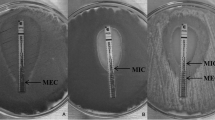Abstract
Twenty-nineAspergillus isolates and 25Fusarium isolates underwent in vitro antifungal susceptibility testing by a broth macrodilution procedure adapted from the National Committee for Clinical Laboratory Standards guidelines. The MIC50s of both voriconazole and amphotericin B were 0.5 μg/ml and 1 μg/ml against species ofAspergillus andFusarium, respectively, while the MIC90s of both agents were 1 and 2 μg/ml. Voriconazole was more active in vitro than amphotericin B: the geometric mean MICs of voriconazole and amphotericin B againstAspergillus spp. were 0.36 μg/ml and 0.64 μg/ml, respectively. Voriconazole also demonstrated fungicidal activity againstAspergillus spp., with 86% (24/29) of isolates exhibiting minimum lethal concentrations of ≤4 μg/ml.
Similar content being viewed by others
References
Anaissie E, Kantarjian H, Ro H, Hopfer R, Rolston K, Fainstein V, Bodey G: The emerging role ofFusarium infections in patients with cancer. Medicine (1988) 67:77–83
Denning DW, Stevens DA: Antifungal and surgical treatment of invasive aspergillosis: review of 2,121 published cases. Review of Infectious Diseases (1990) 12:1147–1201
Sekhon AS, Padhye AA, Gurg AK, Ahmad H, Moledina N: In vitro sensitivity of medically significantFusarium species to various antimycotics. Chemotherapy (1994) 40:239–244
Barry AL, Brown SD: In vitro studies of two triazole antifungal agents (voriconazole [UK-109.496] and fluconazole) againstCandida species. Antimicrobial Agents and Chemotherapy (1996) 40:1948–1949
Belanger P, Nast C, Fratti R, Sanati H, Ghannoum M: Voriconazole (UK-109,496) inhibits the growth and alters the morphology of fluconazole-susceptible and -resistantCandida species. Antimicrobial Agents and Chemotherapy (1997) 41:1840–1842
Nguyen MH, Yu YC: In vitro comparative efficacy of voriconazole and itraconazole against fluconazole-susceptible and fluconazole-resistantCryptococcus neoformans isolates. Antimicrobial Agents and Chemotherapy (1998) 42:471–472
Ruhnke M, Schmidt-Westhausen A, Trautmann M: In vitro activities of voriconazole (UK-109,496) against fluconazolesusceptible and -resistantCandida albicans isolates from oral cavities of patients with human immunodeficiency virus infection. Antimicrobial Agents and Chemotherapy (1997) 41:575–577
Murphy M, Bernard EM, Ishimaru T, Armstrong D: Activity of voriconazole (UK-109,496) against clinical isolates ofAspergillus species and its effectiveness in an experimental model of invasive pulmonary aspergillosis. Antimicrobial Agents and Chemotherapy (1997) 41:696–698
Radford SA, Johnson EM, Warnock DW: In vitro studies of activity of voriconazole (UK-109,496), a new triazole antifungal agent, against emerging and less-common mould pathogens. Antimicrobial Agents and Chemotherapy (1997) 41:841–843
Espinel-Ingroff A, Bartlett M, Bowden R, Chiu NX, Cooper C, Fothergill A, McGinnis MR, Menezes P, Messer SA, Nelson PW, Odds FC, Pasareil L, Peter J, Pfaller MA, Rex JH, Rinaldi MG, Shankland GS, Walsh TJ, Weitzman I: Multicenter evaluation of proposed standardized procedure for antifungal susceptibility testing of filamentous fungi. Journal of Clinical Microbiology (1997) 35:139–143
National Committee for Clinical Laboratory Standards. Reference method for broth dilution antifungal susceptibility testing of yeasts. Tentative standard M27-T. NCCLS, Villanova, PA (1995)
George D, Miniter P, Andriole VT: Efficacy of UK-109496, a new triazole antifungal agent, in an experimental model of invasive aspergillosis. Antimicrobial Agents and Chemotherapy (1996) 40:86–91
Nguyen MH, Clancy CJ, Yu VL, Yu YC, Norris AJ, Snydman DA, Sutton DA, Rinaldi MG: Do in vitro susceptibility data predict the microbiologic response to amphotericin B? Results of a prospective study of patients withCandida fungemia. Journal of Infectious Diseases (1998) 177:425–430
McGinnis MR, Pasareil L, Sutton DA, Fothergill AW, Cooper CR, Rinaldi MG: In vitro evaluation of voriconazole against some clinically important fungi. Antimicrobial Agents and Chemotherapy (1997) 41:1832–1834
Denning DW, Venkateswarlu K, Oakley KL, Oakely MJ, Anderson MJ, Manning NJ, Stevens DA, Warnock DW, Kelly SL: Itraconazole resistance inAspergilllus fumigatus. Antimicrobial Agents and Chemotherapy (1997) 41:1364–1368
Walsh TJ, Melchor GP, Rinaldi MG, Lecciones J, McGough DA, Kelly V, Lee J, Callender D, Rubin M, Pizzo PA:Trichosporon beigelli, an emerging pathogen resistant to amphotericin B. Journal of Clinical Microbiology (1990) 28:1616–1622
Author information
Authors and Affiliations
Rights and permissions
About this article
Cite this article
Clancy, C.J., Nguyen, M.H. In vitro efficacy and fungicidal activity of voriconazole againstAspergillus andFusarium species. Eur. J. Clin. Microbiol. Infect. Dis. 17, 573–575 (1998). https://doi.org/10.1007/BF01708622
Issue Date:
DOI: https://doi.org/10.1007/BF01708622




